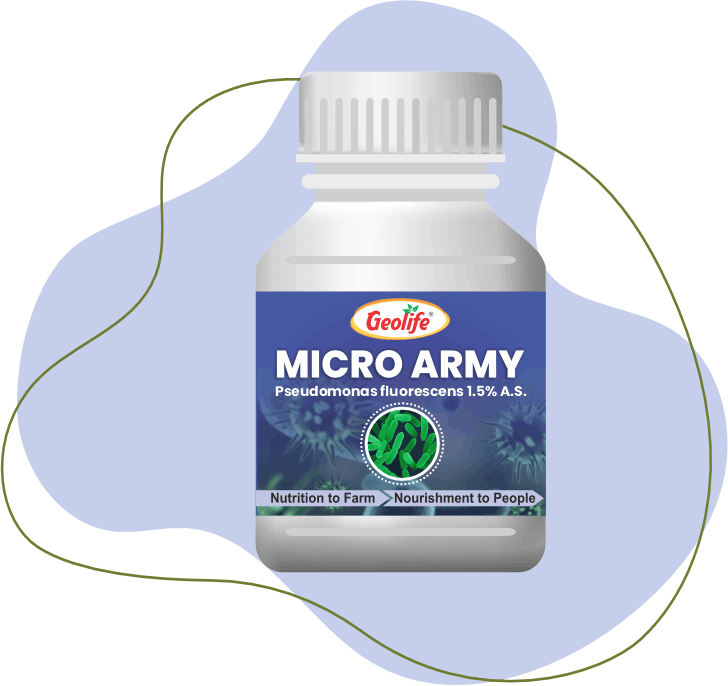
Broad-Spectrum Biopesticides for Effective Crop Protection
Broad-Spectrum Biopesticides for Effective Crop Protection

Broad-Spectrum Biopesticides for Effective Crop Protection
Mode of Action :
Rhizosphere Multiplication: Utilizes seed and root exudates to proliferate in the soil rhizosphere.
Siderophore Production: Produces siderophores that chelate iron in the soil, limiting availability for pathogens and inhibiting their proliferation.
Plant Growth Substances: Secretes gibberellin-like compounds that promote vigorous plant growth and suppress disease-causing pathogens.
Induced Systemic Resistance: Induces systemic resistance in host plants, enhancing their ability to withstand pathogens.
Secondary Metabolite Production: Produces 2,4-diacetylphloroglucinol (2,4-DAPG), which has anti-phytopathogenic and biocontrol properties.
Biofilm Formation: Forms biofilms due to multiple flagella, allowing colonization on various surfaces and providing a protective barrier against parasitic fungi.
Benefits :
Eco-Friendly: Non-toxic and environmentally safe for use in agriculture.
Disease Suppression: Protects seeds and roots from various fungal infections, thereby suppressing plant diseases.
Growth Promotion: Enhances plant growth by producing phytohormones like auxin and gibberellin.
Environmental Stress Adaptation: Adaptable to different environmental stresses, supporting plant resilience.
Increased Metabolic Rate: Enhances the metabolic rate of plants, contributing to improved growth.
Root and Shoot Growth Enhancement: Amylase activity helps metabolize sugars, enhancing root and shoot development.
| Crop | Application Method | Crop Stage |
|---|---|---|
| Rice | Soil Along with organic manures | Initial vegetative stage |
| Corn | Soil Along with organic manures OR Drenching | Initial vegetative stage |
| Wheat | Soil Along with organic manures | Initial vegetative stage |
| Crop | Application Method | Crop Stage |
|---|---|---|
| Chickpeas | Soil Along with organic manures | Initial vegetative stage |
| Pea | Soil Along with organic manures | Initial vegetative stage |
| Soybean | Soil Along with organic manures | Initial vegetative stage |
| Groundnut | Soil Along with organic manures | Initial vegetative stage |
| Crop | Application Method | Crop Stage |
|---|---|---|
| Cotton | Soil Along with organic manures/ Drip/ Drenchnig | Initial vegetative stage |
| Sugarcane | Soil Along with organic manures/ Drip/ Drenchnig | Initial vegetative stage |
| Tobacco | Soil Along with organic manures/ Drip/ Drenchnig | Initial vegetative stage |
| Crop | Application Method | Crop Stage |
|---|---|---|
| Tomato | Soil Along with organic manures/ Drip/ Drenchnig | Initial vegetative stage |
| Brinjal/ Eggplant | Soil Along with organic manures/ Drip/ Drenchnig | Initial vegetative stage |
| Bell Pepper / Chilli | Soil Along with organic manures/ Drip/ Drenchnig | Initial vegetative stage |
| Crop | Application Method | Crop Stage |
|---|---|---|
| Potato / Sweet Potato | Soil Along with organic manures/ Drip/ Drenchnig | Initial vegetative stage |
| Cassava / Yams | Soil Along with organic manures/ Drip/ Drenchnig | Initial vegetative stage |
| Ginger / Turmeric | Soil Along with organic manures/ Drip/ Drenchnig | Initial vegetative stage |
| Crop | Application Method | Crop Stage |
|---|---|---|
| Spinach / Kale / Fenugreek / Amaranth / Celery / Coriander | Soil Along with organic manures/ Drip/ Drenchnig | Initial vegetative stage |
| Lettuce / Cabbage / Cauliflower | Soil Along with organic manures/ Drip/ Drenchnig | Initial vegetative stage |
| Crop | Application Method | Crop Stage |
|---|---|---|
| Rose / Jasmine | Soil Along with organic manures/ Drip/ Drenchnig | Initial vegetative stage |
| Gladiolus / Gerbera | Soil Along with organic manures/ Drip/ Drenchnig | Initial vegetative stage |
| Crop | Application Method | Crop Stage |
|---|---|---|
| Pineapple | Soil Along with organic manures/ Drip/ Drenchnig | Initial vegetative stage |
| Banana | Soil Along with organic manures/ Drip/ Drenchnig | Initial vegetative stage |
| Coconut / Arecanut | Soil Along with organic manures/ Drip/ Drenchnig | Initial vegetative stage |
| Mango | Soil Along with organic manures/ Drip/ Drenchnig | Initial vegetative stage |
| Oil palm / Dates | Soil Along with organic manures/ Drip/ Drenchnig | Initial vegetative stage |
| Berries | Soil Along with organic manures/ Drip/ Drenchnig | Initial vegetative stage |
| Citrus | Soil Along with organic manures/ Drip/ Drenchnig | Initial vegetative stage |
| Grapes | Soil Along with organic manures/ Drip/ Drenchnig | Initial vegetative stage |
| Pomegranate | Soil Along with organic manures/ Drip/ Drenchnig | Initial vegetative stage |
| Jackfruit / Durian | Soil Along with organic manures/ Drip/ Drenchnig | Initial vegetative stage |
| Papaya | Soil Along with organic manures/ Drip/ Drenchnig | Initial vegetative stage |
| Crop | Application Method | Crop Stage |
|---|---|---|
| Lucerne / Berseem / Alfalfa / Napier / Para grass | Soil Along with organic manures/ Drip/ Drenchnig | Initial vegetative stage |
| Crop | Application Method | Crop Stage |
|---|---|---|
| Spinach / Kale / Fenugreek / Amaranth / Celery / Coriander | Soil Along with organic manures/ Drip/ Drenchnig | Initial vegetative stage |
| Lettuce / Cabbage / Cauliflower | Soil Along with organic manures/ Drip/ Drenchnig | Initial vegetative stage |
250 gm per acre / 625 gm per hectare OR
500 ml per acre / 1.25 liters per hectare
Foliar or Soil Application